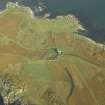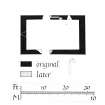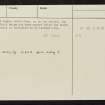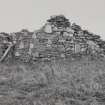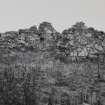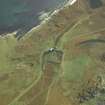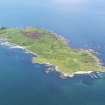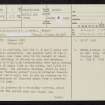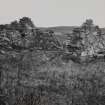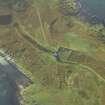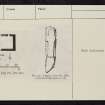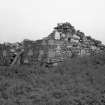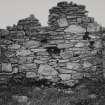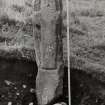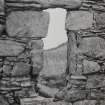Cara, St Fionnlugh's Chapel
Chapel (Medieval)
Site Name Cara, St Fionnlugh's Chapel
Classification Chapel (Medieval)
Alternative Name(s) St Finla's
Canmore ID 38592
Site Number NR64SW 1
NGR NR 64096 44324
Datum OSGB36 - NGR
Permalink http://canmore.org.uk/site/38592
- Council Argyll And Bute
- Parish Gigha And Cara
- Former Region Strathclyde
- Former District Argyll And Bute
- Former County Argyll
NR64SW 1 64096 44324.
(NR 6413 4433) Chapel (NR) (Ruins of)
OS 6" map, (1924)
This chapel is roofless, but the N, W and E walls are tolerably well preserved; the greater part of the S wall, however, now rises only to the height of about 0.6m. The building is oblong on plan and measures 8.8m from E to W by 5.3m transversely over walls having a thickness of about 0.6m at the sides, and 0.81m at the gable ends. The entrance doorway, which is said to have been "Gothick arched" (OSA 1793), is situated towards the W end of the N wall, but is now so ruinous as to retain no features of interest apart from a draw-bar slot in the E jamb. The S wall is pierced by a secondary doorway, which may date from the period when the chapel was incorporated within the offices of Cara House.
The chapel may tentatively be ascribed to the later Middle Ages, but little is known of its history; it first comes on record about the middle of the 15th century and the dedication appears to have been to St Fionnlugh. The chapel is again on record in 1549, but it is not mentioned by Martin, and by the time that Pennant visited the island in 1772 the building had evidently ceased to be used for ecclesiastical purposes; indeed, at this period it is said to have been adapted to serve as a kitchen for the adjacent dwelling-house.
A cross-decorated stone was found inside the chapel on the date of visit. It bears traces of mortar, and would seem therefore to have been re-used as a building material in the fabric of the present structure. The stone is a slab of grey micaceous schist measuring 0.89m in length, 0.20m in width and about 0.06m in thickness. It has been roughly pointed at one end for sticking into the ground, but otherwise shows no trace of dressing; the right edge and the top have, however, sustained some later damage, possibly when the stone was re-used.
The cross, of simple Latin form, is in low relief, the surrounding field being cut away except below the shaft, the base of which is indicated by an incised line.
Statistical Account (OSA) 1793; RCAHMS 1971.

























